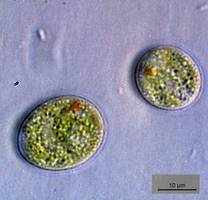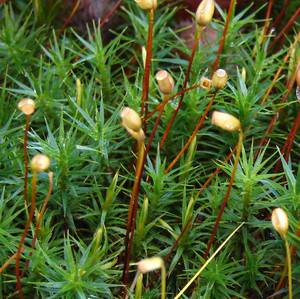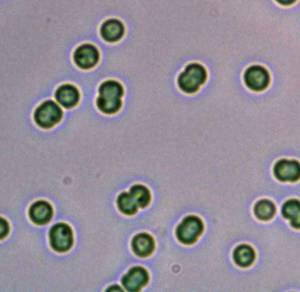News
20.11.2014
Tübingen researchers discover a nitrogen sensor widespread in the plant kingdom
Success story of an evolutionary invention
Quantitatively, nitrogen is one of the most important nutrients for the growth of plant organisms – from simple green algae to highly developed flowering plants. Nitrogen supply is essential for the development of all cell components, and as a good supply results in faster plant growth, it is commonly used as a fertiliser in agriculture. Nitrogen is assimilated in the chloroplasts of plant cells to produce the amino acid glutamine. This molecule serves as a storage form and central distributor that feeds nitrogen into various metabolic pathways. Scientists from the research group of Professor Karl Forchhammer at the Interfaculty Institute for Microbiology and Infection Medicine have investigated how plants keep track of their nitrogen supply. In cooperation with Dr. Marcus Hartmann at the Max Planck Institute for Developmental Biology and colleagues from the University of St. Petersburg, they discovered that plants possess a sophisticated glutamine sensor. So-called PII signalling proteins act as a “fuel gauge” for the amount of available nitrogen by measuring the glutamine concentration. This information is then used by the plants to precisely control their growth.
 | PII signalling protein from Chlamydomonas reinhardtii. The Q-Loop extensions are represented in violet, the glutamine binding sites in green. Image: Karl Forchhammer |
PII signalling proteins are central metabolic regulators that have been thoroughly investigated in bacteria by microbiologist Karl Forchhammer’s team. However, investigations of this protein type in the green algae Chlamydomonas surprisingly revealed that an additional component is required to make the PII proteins work: their signalling function is tightly coupled to the glutamine level. The PII proteins stimulated the production of various other amino acids, the “building blocks” of proteins, but only at high glutamine concentrations. Together with Marcus Hartmann the microbiologists have now determined the three dimensional structure of PII proteins in these algae: in comparison to the bacterial PII proteins they have an additional small extension that the researchers termed the “Q-Loop”. This small loop detects and wraps around free glutamine molecules. “Only when this extension is loaded with glutamine, the PII protein folds into the structure that is necessary to signal and initiate the subsequent metabolic steps”, explains Dr. Vasuki Chellamuthu, the study’s lead author.
 |  |  |
Microscopic images of the single-cell green algae Chlamydomonas reinhardtii. Images: Karl Forchhammer
| ||
In a next step the researchers wanted to find out if this additional trait is unique to the green algae Chlamydomonas, or whether it is a common feature of plants. With bioinformatic methods, they analysed all available genetic blueprints of plant PII proteins. “It turned out that this small extension is present in all plant PII proteins, from green algae to mosses, and all the way to rice and other flowering plants”, state Marcus Hartmann and Karl Forchhammer. The Q-Loop extension is degenerated in only one single plant family: the crucifers. “Curiously Arabidopsis thaliana, or thale cress, an important model organism in plant research, belongs to this family and thus to the exceptions”, they add. The corresponding PII protein in thale cress is, in fact, not glutamine-dependent. However, when the researchers artificially appended the intact Q-loop extension from the algal protein to the thale cress protein in laboratory tests, the response to glutamine was restored – confirming the Q-Loop’s functional role.
 |  |
The moss Physcomitrella (left) has it, while thale cress, Arabidopsis thaliana (right), does not: the glutamine-dependent PII protein. Photographs: Karl Forchhammer
| |
By altering the PII proteins in plants in a targeted manner, the formation of certain metabolic products could be influenced. “Whether the discovery of the nitrogen sensor will have a significant impact on plant breeding remains to be seen”, says Forchhammer. But the discovery has already taught us a lesson in evolution. The nitrogen sensor is an example of how new properties can emerge on the basis of existing components. Chloroplasts were originally cyanobacteria that migrated into cells. These bacteria possessed PII signalling proteins with no extension. However in the plant, it became necessary to directly measure the availability of nitrogen for metabolic control. Therefore, the extension was appended and the signal transmission was coupled to the glutamine level. This trait was so useful that it was passed on to all descendants in the plant kingdom and – with few exceptions – exists to this day.
 |  |
Cyanobacteria: Synechocystis (left) and Anabaena sp. (right). Photographs: Karl Forchhammer | |
Publication:
Vasuki-Ranjani Chellamuthu, Elena Ermilova, Tatjana Lapina, Jan Lüddecke, Ekaterina Minaeva, Christina Herrmann, Marcus D. Hartmann, and Karl Forchhammer: A Widespread Glutamine-Sensing Mechanism in the Plant Kingdom. Cell, DOI 10.1016/j.cell.2014.10.015
Contact:
Prof. Dr. Karl Forchhammer
University of Tübingen
Faculty of Medicine and Faculty of Science
Interfaculty Institute of Microbiology and Infection Medicine
Phone +49 7071 29-72096
<link mail ein fenster zum versenden der>karl.forchhammer[at]uni-tuebingen.de
Dr. Marcus Hartmann
Max Planck Institute for Developmental Biology
Phone +49 7071 601-323
<link mail ein fenster zum versenden der>marcus.hartmann[at]tuebingen.mpg.de
The University of Tübingen
Innovative. Interdisciplinary. International. Since 1477. These have always been the University of Tübingen’s guiding principles in research and teaching. With its long tradition, Tübingen is one of Germany’s most respected universities. Tübingen’s Neuroscience Excellence Cluster, Empirical Education Research Graduate School and institutional strategy are backed by the German government’s Excellence Initiative, making Tübingen one of eleven German universities with the title of excellence. Tübingen is also home to six Collaborative Research Centers, participates in five Transregional Collaborative Research Centers, and hosts six Graduate Schools.
Our core research areas include: integrative neuroscience, clinical imaging, translational immunology and cancer research, microbiology and infection research, biochemistry and pharmaceuticals research, the molecular biology of plants, geo-environment research, astro- and elementary particle physics, quantum physics and nanotechnology, archeology and prehistory, history, religion and culture, language and cognition, media and education research.
The excellence of our research provides optimal conditions for students and academics from all over the world. 28,500 students are currently enrolled at the University of Tübingen. As a comprehensive research University, we offer more than 280 subjects. Our courses combine teaching and research, promoting a deeper understanding of the material while encouraging students to share their own knowledge and ideas. This philosophy gives Tübingen students strength and confidence in their fields and a solid foundation for interdisciplinary research.
The Max Planck Institute for Developmental Biology
The Max Planck Institute for Developmental Biology conducts basic research in the fields of biochemistry, genetics and evolutionary biology. It employs about 350 people and is located at the Max Planck Campus in Tübingen. The Max Planck Institute for Developmental Biology is one of 80 research institutes that the Max Planck Society for the Advancement of Science maintains in Germany.
